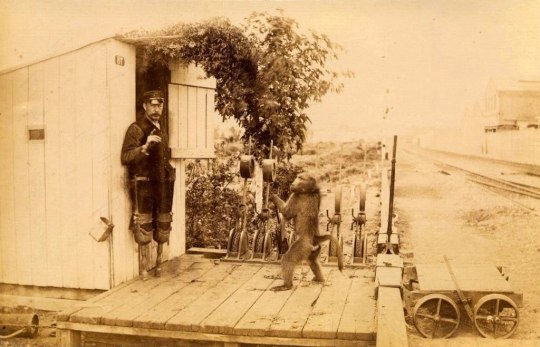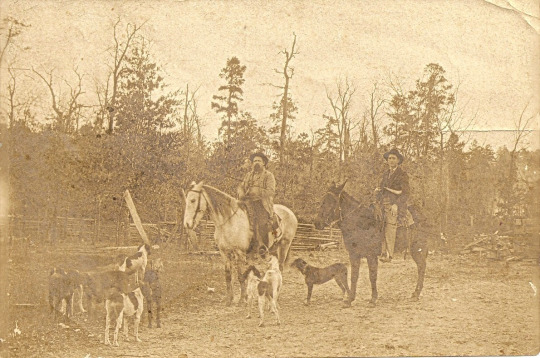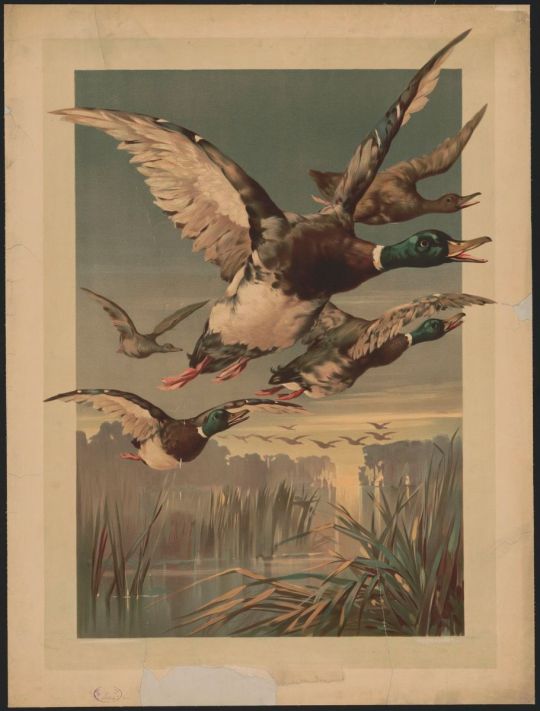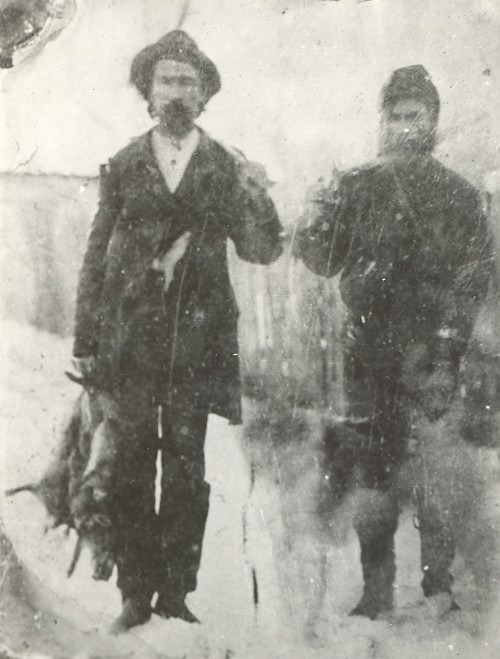#animalhistory
Text
Arkansas Hunters from the Past: Woods Stroud in December 1897
Woods Stroud, a farmer from Rogers, with two wild turkeys and his dog at Beaton Photography Studio in 1897. Stroud was born in 1858, three years before the outbreak of the American Civil War. He died in 1833.
Taken from Ancestry.com

View On WordPress
#animalhistory#arkansas#arkansashistory#arkansashunting#arkansasoutdoors#arkansaswildlife#earlyarkansas#environment#huntingishistory#thenaturalstate#vintagehunter#vintagehunters#vintagehunting
0 notes
Text
The Jumper, Jack, and the Railroad Tracks
The town of Uitenhage, located in the Eastern Cape Province of South Africa, was founded in the early 1800s and by the 1870s it was a stop for the thousands traveling along the Port Elizabeth Mainline Railroad from Port Elizabeth to the capital city of Capetown. Working the signals at the town’s train station was a man named James Wide, better known as “Jumper”, and his assistant. The station ran smoothly until the day the two were visited by their superiors. When they saw what was going on they were completely stunned.
“Jumper” Wide was a railway man who earned his nickname. While working as a guard for the Cape Town’s Port Authority Railway Service he became known for his preferred method of traveling between the trains, jumping and swinging on ropes in between the rail cars, regardless if they were moving. It was while jumping between the cars one day in 1877 that tragedy struck. Jumper slipped on a canvas and fell straight down to the tracks directly in the path of a moving train. The massive metal wheels crunched over Jumper’s legs, severing them both at the knee and leaving him unable to perform his job. After recovering from his injuries, Jumper pleaded with the railway to somehow keep him on as an employee and he was eventually assigned to the Uitenhage station to serve as a signalman.
Wide adapted to his new circumstances as best he could, carving himself a set of wooden peg legs that strapped onto his body and building a wooden cart to help wheel himself from his home to the train station. One Saturday morning Wide was pushing himself around a bustling Uitenhage marketplace when he saw a team of oxen being led through the market, completely under the control of an amazingly capable chacma baboon. Seeing how much the animal was helping the man driving the oxen, it dawned on Wide how much a companion like the baboon could help him in his daily life. He spied the owner, wheeled his cart over to introduce himself, and asked him if he would ever consider parting ways with his furry companion. With Wide sitting before him on a cart with two carved wooden legs the oxen driver had a difficult decision to make, but in the end he agreed to hand his beloved baboon over to Wide. He had one vital piece of advice, if he wanted to keep the baboon happy he had to give him a small cup of “good Cape brandy” every night. Otherwise, he would sulk the next day and refuse to help until he got his preferred beverage.

Chacma baboon. Image via Wikipedia.
Although there were a few times that Wide forgot the brandy and learned that the ox driver’s warning was true, he and his new companion, now named Jack, became very fast friends. Jack was extremely intelligent and absorbed his new surroundings with ease, quickly learning how to help Wide clean his small home and waking each morning to accompany him to the Uitenhage train station for the workday. The two shared a small cottage located half a mile from the station and each morning Wide would sit on his handcrafted cart while Jack pushed him to work. Along the route was a small hill and Jack would push his friend to the top before jumping on the cart and riding down the other side together. Ever-observant, Jack would spy old condemned wooden railway sleepers and bring pieces back to Wide to use as firewood. He learned to help sweep, clean up garbage, and became a faithful guardian, snarling and gnashing his teeth at anyone who came near until he was assured the visitor was safe. Jack was always willing to help Wide, and soon his incredible learning ability began to reveal itself in a remarkable way.

Wide and Jack with Wide’s trolley cart. Image via Wikimedia Commons.
Part of Wide’s job as a signalman at the railway station was to listen for the approaching trains so that he could hand them a key that allowed them to get into the coal sheds. The key was kept near the signal box and every day when Wide would hear the familiar four blasts from an approaching train’s whistle he would hobble out to the platform on his crutches and hold the key out to the locomotive driver. One day Wide heard the whistles calling him and before he could get to his crutches he watched as Jack jumped up, went out to the platform, grabbed the key, and successfully handed it off to the surprised conductor.
Handling the signals at the station was a hugely important job that required absolute accuracy. Different blasts from the train whistles required signals to be changed in order to direct the trains safely and Wide wondered if his friend Jack could figure out the task. It began with Wide showing Jack how to pull the levers, then he developed hand signals to tell Jack which levers to pull for which whistle blow. Amazingly, within a few weeks Jack the baboon had successfully memorized the various whistle patterns and was able to turn the correct signals over and over again. Wondering if it was just a matter of Jack memorizing a set schedule, he decided to test him, asking conductors to send different signals to see if it would trip up the baboon. He never failed once.

Wide and Jack at the signal levers. Image via Wikimedia Commons.
The news about the train station being run by a baboon spread fast and, for the most part, it was a story that people loved, bringing passengers to their train windows to witness Jack standing on the platform with Wide standing behind him on his hand-carved wooden legs. But, one day the train had a very prominent woman riding on board and the sight and story of Jack did not delight her, she was absolutely horrified. Fearing for her safety, she reported Jack to authorities in Cape Town. Inspectors went to the station and upon finding the signals being handled by a baboon, they quickly dismissed Wide from his job.
Wide once again found himself pleading for his place in the railroad, insisting to the system manager that Jack was more than able of performing the job as signalman and begging for the opportunity to show them just how capable he was. Finally, for reasons unknown, the manager finally agreed to test Jack. A conductor was given a long list of secret sequences that he would blast from the train whistle and wait for the baboon’s response. To the complete and utter amazement of everyone present, Jack answered every last whistle blast by pulling the correct set of levers to switch the signals. Not only did he respond with the right signals at precisely the right time, they also witnessed him looking down the tracks to where an oncoming train would be approaching to make sure the signals were correct down the line. The manager and his associates could not deny what they saw. Jack was completely fluent in the train signals, even double checking his work in front of them. What they saw was impressive. Wide got his job back, but they also officially hired Jack, granting him an official railroad employee number and paying him a ration of twenty cents a day and half a bottle of beer weekly. Jack the Signalman was official.
He was also here to stay. Jack continued working for the railroad with his friend Wide, who he doted on. After a visit to the station in 1890 the railway superintendent George B. Howe wrote: “Jack knows the signal whistle as well as I do, also every one of the levers…It was very touching to see his fondness for his master. As I drew near they were both sitting on the trolley. The baboon’s arms round his master’s neck, the other stroking Wide’s face.”

Wide and Jack at their train station. Image via Wikipedia.
Jack manned the signals at the railway station with Wide for nine years before he passed away from tuberculosis in 1890. During those nine years on the job Jack the signalman baboon never made a single mistake.
Today, Jack’s skull is on display at the Albany Museum in Grahamstown, South Africa.
#HushedUpHistory#History#featuredstories#SouthAfrica#SouthAfricaHistory#Railroad#Railroadhistory#Baboon#Serviceanimal#RailroadSignal#MansBestFriend#Animals#AnimalHistory#AnimalsAreTheBest#Trains#TrainHistory#HistoryofTrains#BestFriends#WeirdHistory#ForgottenHistory#StrangeHistory#TruthisStrangerThanFiction#HistoryisWild#HistoryClass#Historyiscool#HistoryisNotBoring#AnimalStories#TrueStory
2 notes
·
View notes
Photo

How cool is this penguin messenger? . . . #ceramics #handmade #pottery #instapottery #madeintn #makersgonnamake #madeinnashville #pottersofinstagram #figurine #art #animalfigurine #shopsmall #animalhistory #instaart #animalsofinstagram #whimsicalart #tinyanimals #ceramicanimals #fantasyart #prayerbox #wishbox #amulet #protectionspell #animalsculpture #animalspirit #penguin #emperorpenguin #penguinfigurine #penguinsculpture #cutepenguin https://www.instagram.com/p/B2M-OZZg7AQ/?igshid=1xoo1whu33gxo
#ceramics#handmade#pottery#instapottery#madeintn#makersgonnamake#madeinnashville#pottersofinstagram#figurine#art#animalfigurine#shopsmall#animalhistory#instaart#animalsofinstagram#whimsicalart#tinyanimals#ceramicanimals#fantasyart#prayerbox#wishbox#amulet#protectionspell#animalsculpture#animalspirit#penguin#emperorpenguin#penguinfigurine#penguinsculpture#cutepenguin
1 note
·
View note
Photo

Heading in and out of London going west you are bound to come across one of the most amazing architectural feats #London has to offer @natural_history_museum. Opened in 1881, architect Alfred Waterhouse. One side in terracotta displays animals that are extinct and the other those still alive however since the completion of the building those still existing have unfortunately become extinct. . . . #history #naturalhistory #england #britain #fossil #animal #animalhistory #dinasour #bluewhales #looktothefuture (at Natural History Museum, London) https://www.instagram.com/p/B29yQDjHUb8/?igshid=11qjo00c5rex6
#london#history#naturalhistory#england#britain#fossil#animal#animalhistory#dinasour#bluewhales#looktothefuture
0 notes
Link
The Danube River is the second longest river in Europe; it flows through ten countries and is 2,850 km in length. In its lower stretches it passes through large lowlands and remains an almost intact natural ecosystem. For 470 km, the river acts as a border between Bulgaria and Romania and provides a refuge for very rich, yet insufficiently studied, biodiversity. The flora and fauna of this area, not far from the Danube Delta biosphere reserve, and its environmental importance are the topics of this book.
The book is comprised of 12 separate scientific articles (chapters) that each contain specialized information about key organism groups forming the typical Lower Danube ecosystem. Vertebrate fauna of the study region includes 392 species out of which 83 species are fishes, 19 are amphibians, 15 are reptiles, 201 are birds, and 74 are mammals. Birds are presented in three separate articles with a focus on heron colonies, water birds in the marshlands, and diurnal raptors. Among the invertebrates, several key groups which are comparatively well-studied, are presented, including mollusks; dragonflies and damselflies (in overall 52 species); dipterans of suborder Nematocera (153 species); mayflies (52 species); stoneflies (3 species); and caddisflies (49 species), butterflies (153 species). An article about habitats and typical plants of the Danube plain is also included.
The articles all contain information on the status, distribution and ecology of the study’s organism groups, and the threats they face. Overall numbers and population trends of some of the presented taxa are also included; 281 maps, 29 graphs, 21 tables and 49 photographs help illustrate various aspects of the collected data. The authors of the articles are well-known and experienced experts on specific organism groups, working mainly out of two institutions of the Bulgarian Academy of Sciences: the National History Museum (Sofia) and the Institute of Biodiversity and Ecosystem Research (Sofia).
(Imprint: Nova)
#reading#nationalmuseum#museum#history#naturalhistory#biodiversity#bulgarian-Romanian#animalscience#animals#researchforanimals#science#scienceresearch#animalresearch#animalhistory#lifesciences#bulgarianacademy#biology#life#organisms#organism#ivertebrates#species#readingtime#education#educate#educational#student#graduate#graduatestudentreading#readinglevel
0 notes
Text


The problem with being a historian is I gotta look up bugs. Today, it’s the Colorado Potato Beetle, also called Leptonotarsa decemlineata. I’m probably going to make a hot topics in history because this topic is fairly interesting, so stay tuned
#entymology #bugs #bughistory #animalhistory #historyofanimals #historyofbugs #potato #historyoffood #worldhistory #coloradopotatobeetle
0 notes
Text
GoldenGusTweeted
I’m looking to put together a panel on animals, environment, and science for HSS2018. My own work deals with vet med, wildlife, and disease, but I’m open to different kinds of #animalhistory. Any takers? #hss2018 #environmentalhistory #horsehistory
— Katie Sullivan (@kasullivan19) March 11, 2018
0 notes
Photo

I have a weird love for dead things 💀 here's some shit from under the museum #skull #skulls #dead #deadass #deadanimals #deadanimal #animalhistory #animal #animals #animalanatomy #rabbit #art #artist #artistic #artsy #macabre #artistonistagram #artistsofinstagram #creep #creepy #deadthings #bird #birds #skunk #racoon #loin #tiger #deer #foxskull #rabbitskull
#creepy#dead#foxskull#animalanatomy#animal#rabbitskull#deer#artistic#artist#rabbit#animals#bird#deadanimals#skulls#macabre#artsy#skull#birds#racoon#tiger#artistonistagram#deadass#deadanimal#art#artistsofinstagram#skunk#loin#deadthings#animalhistory#creep
0 notes
Text
Arkansas Hunters from the Past: Frank Leslie from Gillett in 1895
Frank Leslie (b. 1873) was a longtime cook and camp manager for Jacobs Lake Hunting Club On Jacobs Lake NW of Gillett. Today it is known as the Tuff Nutt Hunting Club. Leslie was killed in a train accident in 1896. This picture is from about 1895.
Image from Ancestry.com

View On WordPress
#animalhistory#arkansas#arkansashistory#arkansashunting#arkansasoutdoors#arkansaswildlife#arkansaswildlifehistory#envhistory#environment#foresthistory#huntingishistory#thenaturalstate#vintagehunter#vintagehunting
0 notes
Text
Early Arkansas Hunters: Dallas County, 1905
Circa 1905, Elon H. Fielder (b. 23 AUG 1853) is on a white horse with a powder horn. His son, Claud R. Fielder (b. 13 JAN 1882), has a hunting horn around his neck (used to call the dogs). They have a pack of hounds. The pair are about to head off on a deer hunt in Dallas County, Arkansas. Notice the split rail fence in the background.
Source: Ancestry.com

View On WordPress
#arkansas#arkansashistory#arkansashunters vintagehunting vintagehunters envihistory animalhistory huntingdogs#arkansashunting#arkansasoutdoors#arkansaswildlife#arkansaswildlifehistory#deerhunting#earlyarkansas#envihistory#horseback#hounds#huntingdogs#huntingishistory#thenaturalstate#vintagehunter#vintagehunters
0 notes
Text
Early Arkansas Hunting Clubs: 1885 Blackfish Club and the 1888 Bald Knob Rod and Gun Club
In 1885, Dr. Henry White and tanner Frederick Scheibler helped organize Blackfish Club for organized fishing on the lower portion of the Blackfish and Shell Lake in Arkansas near Quigley. Because of rough roads from Quigley to the clubhouse, the organization planned to build a railway tram from the station to the lodge. Some of the members purchased land near the clubhouse and leased it for…

View On WordPress
#arkansas#arkansashistory#arkansashunters vintagehunting vintagehunters envihistory animalhistory huntingdogs#arkansashunting#arkansasoutdoors#arkansaswildlife#arkansaswildlifehistory#earlyarkansas#envhistory#environment#huntingclubs#huntingishistory#thenaturalstate
0 notes
Text
Early Arkansas Hunters: 1847 Lawrence County
Settler Uriah Cole’s family built a house in 1847 and cleared land for a farm in Lawrence County. After completing his chores, young Cole hunted for sport, “I amused myself by hunting, and never was out of sight of deer. I have seen 500 wild turkeys in a drove and killed them till I was no longer interested.” Cole became a well-known bear hunter in the area, and people came from as far as…

View On WordPress
#arkansas#arkansashistory#arkansashunters vintagehunting vintagehunters envihistory animalhistory huntingdogs#arkansashunting#arkansasoutdoors#arkansaswildlife#arkansaswildlifehistory#earlyarkansas#envihistory#environment#huntingishistory#lawrencecounty#thenaturalstate
0 notes
Text
Early Arkansas Hunters: 1847 Lawrence County
Settler Uriah Cole’s family built a house in 1847 and cleared land for a farm in Lawrence County. After completing his chores, young Cole hunted for sport, “I amused myself by hunting, and never was out of sight of deer. I have seen 500 wild turkeys in a drove and killed them till I was no longer interested.” Cole became a well-known bear hunter in the area, and people came from as far as…

View On WordPress
#arkansas#arkansashistory#arkansashunters vintagehunting vintagehunters envihistory animalhistory huntingdogs#arkansashunting#arkansasoutdoors#arkansaswildlife#arkansaswildlifehistory#earlyarkansas#envihistory#environment#huntingishistory#lawrencecounty#thenaturalstate
0 notes
Photo

(via Early Arkansas Hunters: Randolph County circa 1880)
#arkansas #arkansashunting #rabbithunting #huntingdogs #earlyarkansas #arkansaswildlife #snowhunting #huntingdog #vintagehunting #vintagepicture #authenticarkansas #huntingishistory #arkansashistory #arkansaswildlifehistory #arkansasoutdoors #thenaturalstate #arkansaswildlife #earlyarkansas #huntingishistory #environment #vintagehunter #vintagehunting #vintagehunting #envhistory #animalhistory #huntinglicense #wildlifeconservation
0 notes
Text
Early Arkansas Hunters: Aaron Thompson, Phillips County, Arkansas Early 1930s with Live Decoys
Photos: Ancestry.com
#arkansas #arkansashistory #arkansashunting #arkansaswildlifehistory #arkansasoutdoors #thenaturalstate #arkansaswildlife #earlyarkansas #huntingishistory #environment #vintagehunter #vintagehunting #vintagehunting #envhistory #animalhistory #huntinglicense #wildlifeconservation #nonresidenthunters #deerhunting #bearhunting #turkeyhunting #duckhunting #duckhunters

View On WordPress
#arkansas#arkansashistory#arkansashunting#arkansasoutdoors#arkansaswildlife#arkansaswildlifehistory#avery#benelli#beretta#duckhunter#duckhunting#earlyarkansas#environment#huntingishistory#livedecoys#thenaturalstate
0 notes
Photo

It’s taking me some time to take pictures of everything but I’m excited because they look so cute! I really like this polar bear. At the beginning, without the gold, it looked as if he was wearing pants 😂 Not anymore! . . . #ceramics #handmade #pottery #instapottery #madeintn #makersgonnamake #madeinnashville #pottersofinstagram #figurine #art #animalfigurine #shopsmall #animalhistory #instaart #animalsofinstagram #whimsicalart #tinyanimals #ceramicanimals #fantasyart #prayerbox #wishbox #amulet #protectionspell #animalsculpture #animalspirit #bear #bearsculpture #cutebear #bearfigurine #polarbear https://www.instagram.com/p/B1ZickGgjAQ/?igshid=1lx33ucepxu6x
#ceramics#handmade#pottery#instapottery#madeintn#makersgonnamake#madeinnashville#pottersofinstagram#figurine#art#animalfigurine#shopsmall#animalhistory#instaart#animalsofinstagram#whimsicalart#tinyanimals#ceramicanimals#fantasyart#prayerbox#wishbox#amulet#protectionspell#animalsculpture#animalspirit#bear#bearsculpture#cutebear#bearfigurine#polarbear
1 note
·
View note